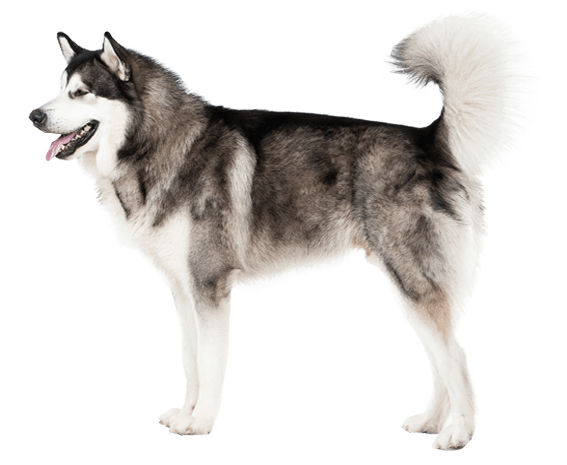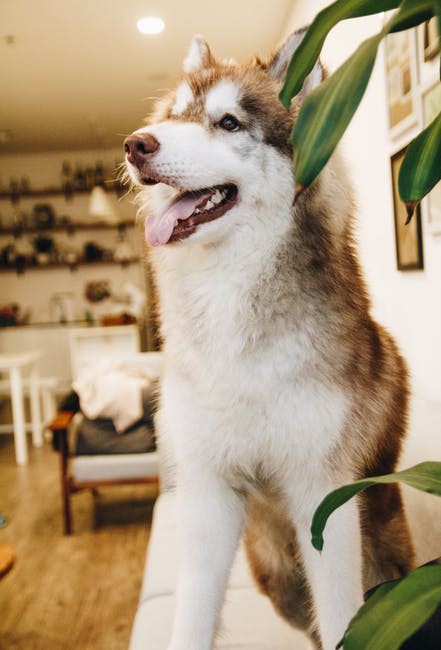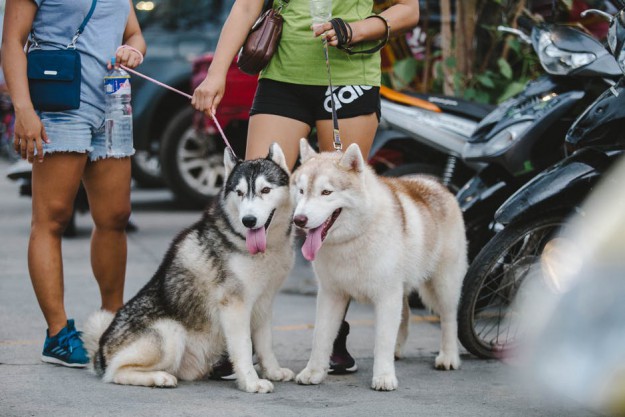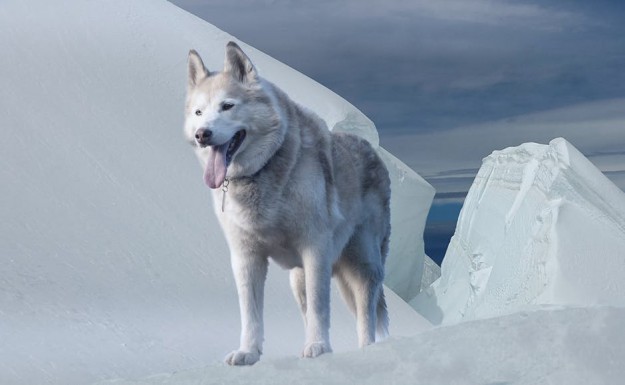
Alaskan Malamute
USD $1200-$1500 Price Avg.
Sled Dogs
Group
Purebred
Breed Type
Large
Size
12-15 years
Lifespan
Breed Information
| Group | Sled Dogs |
|---|---|
| Popularity/Rank | 59 |
| Origin | United States |
| Other Names | Mal, Mally |
| Breed Type | Purebred |
| Price (Avg.) |
USD $1200-$1500
How much does it cost to purchase a Alaskan Malamute? The price of a Alaskan Malamute will vary from breeder to breeder as well as from place to place. As a rough guide, you should expect to pay between $1200 to $1500 per Alaskan Malamute if you purchase from a reputable breeder. Prices will be higher for show-quality dogs with a distinguished pedigree. Adult dogs who have already been trained may cost even more. It is usually less expensive to adopt a Alaskan Malamute through a shelter. |
| Size | Large |
| Weight |
Male: 80 - 95 pounds (36 - 43 kg),
Female: 70 - 85 pounds (32 - 38 kg) |
| Height |
Male: 24 - 26 inches (61 - 66 cm),
Female: 22 - 24 inches (56 - 61 cm) |
| Lifespan | 12-15 years |
| Recognized by |
AKC, FCI
The American Kennel Club in 1935 as a Working breed. And FCI in the Spitz and primitive types group, in the Nordic Sledge Dogs section. |
| Purpose | Heavy Sled Pulling, Large Game Hunting |
| Date of Origin | Ancient Times |
| Ancestry | Spitz |
Appearance & Maintenance
| Coat | Dense, Rough, Thick, Weather-resistant |
|---|---|
| Coat Colors | Black, Gray, Red, White |
| Grooming Level | |
| Shedding Level | |
| Eye Color Possibilities | Brown |
| Nose Color Possibilities | Black, Brown |
| Coat Color Possibilities | Black, Blue, Brown, Gray, Red, Sable, Silver, White |
| Coat Length | Medium |
| Coat Density | Dense |
| Coat Texture | Straight |
| Recommended Brushes | Deshedder, Nail Clipper, Pin Brush, Slicker Brush |
| Brushing Frequency | Weekly |
Breed Characteristics
| Temperament | Affectionate, Caring, Dedicated, Devoted, Dignified, Friendly, Loyal, Playful, Sportive |
|---|---|
| Intelligent | |
| Trainability | |
| Playfulness | |
| Sensitivity Level | |
| Affection Level | |
| Social Interaction Required | |
| Barking | |
| Watchdog Ability | |
| Territorial | |
| Biting Force | Moderate |
| Mouthiness | |
| Impulse to Wander or Roam | |
| Prey Drive | |
| Adaptability | |
| Tolerates Being Left Alone | |
| Fighting Dog | Yes |
Good & Friendly with
| Apartment Life Friendly | |
|---|---|
| Stranger Friendly | |
| Kid-Friendly | |
| Cat Friendly | |
| Dog Friendly | |
| Office Friendly | No |
| Senior Citizens Friendly | |
| Pet Friendly | |
| Friendly with First Time Owners | No |
| Service Dog | Not really |
| Therapy Dog | Not really |
| Detection, Sniffer or Security Dog | Not really |
| Search and Rescue Dog (SAR) | Not really |
| Boat Dog | Not really |
| Cart Pulling or Drafting Dog | Not really |
Health Elements
| Health Issues | |
|---|---|
| Health Problems | Cataracts, Chondrodysplasia, Hemeralopia, Hip Dysplasia, Hypothyroidism, Inherited Polyneuropathy |
| Hypoallergenic | No |
| Energy Level | |
| Exercise Required | |
| Sleeping Required | |
| Weight Gain Potential | |
| Weather & Climate | Prefers cold weather |
| Stinkiness | Low |
| Drooling tendency | |
| Activity Level | High |
| Rec. Walk Mileage Per Week | 10 miles |
| Minutes of Activity Per Day | 90 minutes |
Food & Costing
| Avg. Daily Food | Recommended daily amount: 4 to 5 cups of high-quality dry food a day, divided into two meals. |
|---|---|
| Cups Per Day | 3 cups |
| Daily Cost | $2.00 - $2.25 |
| Monthly Cost | $60.00 - $67.50 |
Reproducibility
| Gestation Duration | 60-64 days |
|---|---|
| How often can the Alaskan Malamute have a litter? | Once a year. |
| Litter Size | 4-10 puppies (Once a year.) |
Description
The Alaskan Malamute is a large, powerful dog breed that originated in Alaska. They are known for their thick, double-layered coat and their strong, muscular build. The Alaskan Malamute is a loyal and devoted companion that loves to be around its family.
Appearance: The Alaskan Malamute has a thick double-layered coat that comes in various colors such as black and white, gray and white, sable and white, red and white, or solid white. They have a broad head with small ears that are set high on the head. Their eyes are almond shaped with dark rims around them. The tail of the Alaskan Malamute is usually carried over the back when they are excited or alert.
Lifespan: The average lifespan of an Alaskan Malamute is between 10 to 14 years old.
Size: An adult male can reach up to 25 inches tall at the shoulder while an adult female can reach up to 23 inches tall at the shoulder.
Weight: An adult male can weigh up to 85 pounds while an adult female can weigh up to 75 pounds.
Colors: As mentioned above, they come in various colors such as black and white, gray and white, sable and white, red and white or solid white.
Personality: The Alaskan Malamute is known for being loyal companions who love spending time with their families but also enjoy having some alone time too! They are intelligent dogs who need plenty of mental stimulation in order to stay happy and healthy so it’s important for owners to provide them with plenty of activities such as walks or playing fetch games in order for them not become bored or destructive indoors!
Friendliness towards other dogs/animals/children: Generally speaking the Alaskan Malamutes get along well with other animals if they have been socialized properly from a young age but it’s important for owners to supervise any interactions between their pet dog(s) just in case any issues arise! When it comes to children they tend to be very gentle but due their size it’s important for owners not leave them unsupervised around small children just in case any accidents occur!
Temperament: The temperament of an Alaskan Malamutes tends vary depending on how much exercise they receive each day as well as how much mental stimulation they receive too! If these needs aren’t met then this breed may become destructive indoors so it’s important for owners provide them with plenty of activities throughout each day! Generally speaking though this breed tends be quite calm yet alert when out on walks which makes them great watchdogs too!
Health: Generally speaking this breed doesn’t suffer from many health issues however there have been reports of hip dysplasia occurring within some lines so it’s important potential owners research into this before purchasing one if possible! Other than this though there aren’t many health concerns associated with this breed which makes them great pets overall!
Adaptability level & Benefits as Pets : This breed does best when living within a home environment where there is plenty space available both inside & outside (if possible) so that they can get enough exercise throughout each day without becoming bored or destructive indoors due lack activity levels provided by their owner(s). This breed also loves spending time outdoors exploring new places & meeting new people which makes them great companions overall - especially if you live within rural areas where there isn't much traffic about either!. In terms of adaptability levels - these dogs do best when living within homes where someone is present most days out week (as opposed apartments/condos etc) since these breeds need lots attention & love from their owner(s). Finally - these breeds make great pets overall since they're loyal companions who love spending time outdoors exploring new places & meeting new people - plus due their size & strength - these breeds make excellent watchdogs too!.
History
The Alaskan Malamute is a large breed of domestic dog originally bred for hauling heavy loads in cold climates. They are similar to other arctic breeds, such as the Greenland Dog, Canadian Eskimo Dog, Samoyed, and the Siberian Husky. However, the Alaskan Malamute is larger and more powerful than most other arctic breeds, and was used more for sledding than pulling loads.
The Alaskan Malamute breed nearly became extinct in the early 1900s due to a number of factors, including over-hunting of their main prey (seals) and competition from other sled dog breeds such as the Siberian Husky. However, a few dedicated breeders kept the breed alive, and it eventually regained popularity.
The ancestry of the Alaskan Malamute is unclear, but it is believed that they are descended from dogs brought to Alaska by Inuit people centuries ago. The first written record of the breed was in 1885, when a pair of dogs was brought from Alaska to Massachusetts by explorer Robert Peary. The breed was recognized by the American Kennel Club in 1935.
Today, the Alaskan Malamute is still used for sledding in some parts of the world, but is more commonly kept as a pet. They are loyal and affectionate companions, but require a lot of exercise and space due to their large size.
Alaskan Malamute Posts
Explore Alaskan Malamute's photos, videos, activities, stories, and facts.







